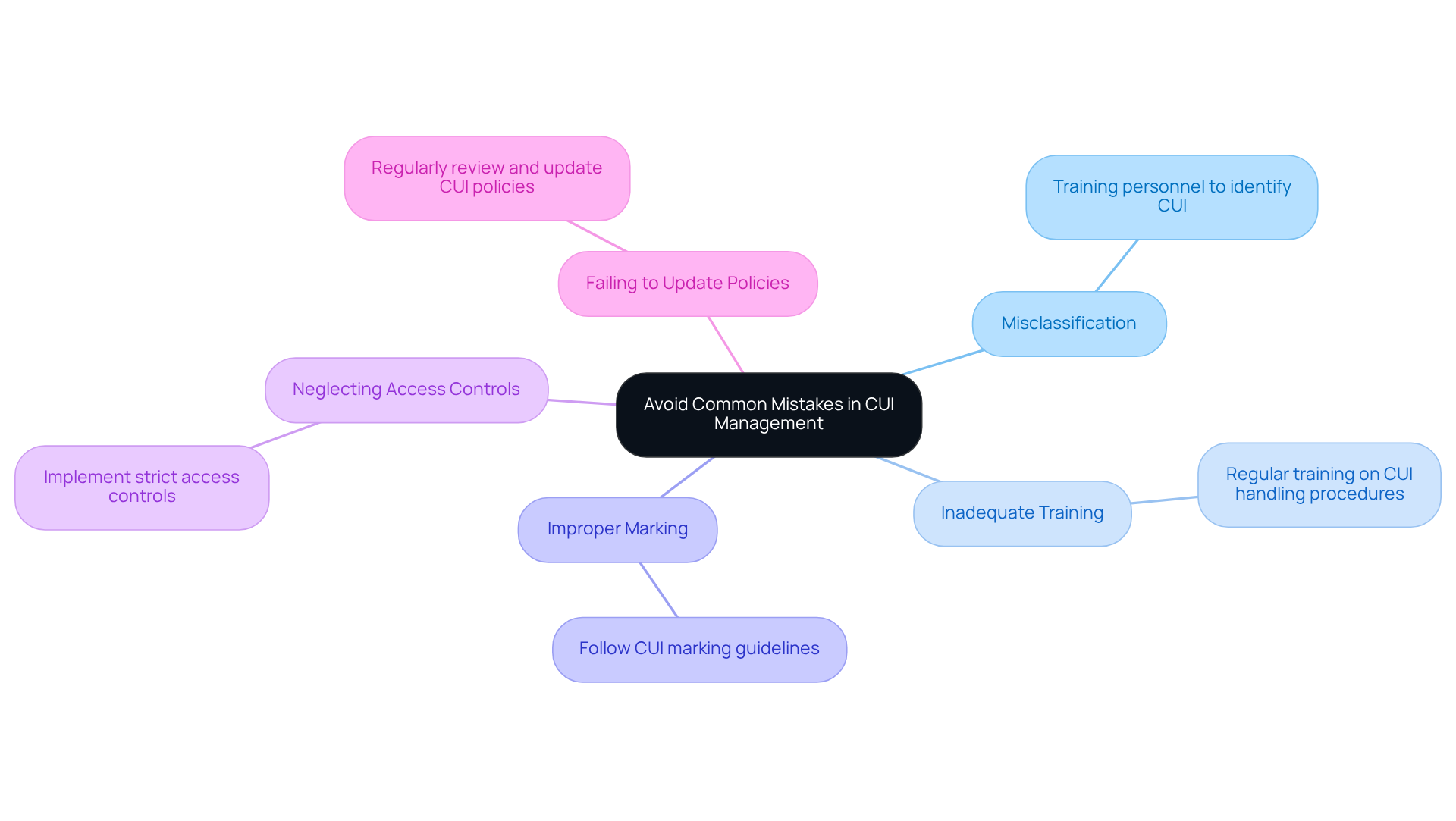Ensure Compliance at the Time of CUI Creation: Key Steps for Defense Contractors
Ensure compliance at the time of CUI creation with essential steps for defense contractors.

Overview
This article outlines the essential steps that defense contractors must undertake to ensure compliance in the creation of Controlled Unclassified Information (CUI). Clearly defining roles and responsibilities is crucial; it sets the foundation for effective management of CUI. Additionally, the article highlights the importance of accurately categorizing and marking CUI, which is vital for maintaining adherence to regulatory standards. Furthermore, it addresses common mistakes that organizations often make, underscoring the necessity of vigilance in this area. By following these guidelines, defense contractors can significantly enhance their compliance efforts and protect sensitive information.
Introduction
Understanding the intricacies of Controlled Unclassified Information (CUI) is essential for defense contractors navigating the complex landscape of compliance and security. As regulatory scrutiny intensifies, effectively managing CUI becomes paramount—not only to safeguard sensitive information but also to bolster an organization's credibility and operational integrity.
However, the path to compliance is riddled with challenges, including misclassifications and inadequate training. This raises a critical question: what key steps must defense contractors take to ensure they are not only compliant but also proactive in their CUI management practices?
By addressing these challenges head-on, organizations can position themselves as leaders in compliance and security.
Understand Controlled Unclassified Information (CUI)
Controlled Unclassified Information (CUI) is defined as sensitive information created or possessed by the U.S. government that mandates safeguarding or dissemination controls, yet does not qualify for classification. To fully grasp the concept of CUI, it is crucial to recognize its various categories, including Controlled Technical Information (CTI) and other specific designations. Have you familiarized yourself with the CUI Registry? This resource offers comprehensive definitions and examples of the different types of CUI, serving as a foundational tool for compliance.
Understanding CUI is essential for ensuring adherence to the Cybersecurity Maturity Model Certification (CMMC) and other regulatory standards. The Info Hub stands as an extensive resource, delivering practical solutions and insights to help you navigate the complexities surrounding CUI and its related regulations. For a deeper understanding, consider consulting resources such as the GSA CUI Program Guide and the National Archives CUI overview.
Moreover, it is important to reflect on common inquiries regarding CUI and associated standards. For instance:
- How can you effectively recognize CUI within your organization?
- What measures are necessary for its proper management and protection?
Engaging with community insights available through the CMMC Info Hub can significantly enhance your understanding and preparedness, making you better equipped to handle CUI effectively.

Determine Responsibilities During CUI Creation
It is crucial to establish who holds responsibility for the management of Controlled Unclassified Information (CUI) at the time of CUI creation. This typically includes roles such as:
- Data creators
- Information security officers
- Regulatory managers
Each position must have clearly defined responsibilities that encompass identifying CUI, applying appropriate labels, and ensuring adherence to proper handling procedures.
To effectively manage CUI, organizations should develop a comprehensive CUI program that delineates these roles and responsibilities. This program must incorporate robust policies and procedures to guarantee that security controls are implemented consistently and effectively. Additionally, providing training is essential to ensure that all employees comprehend their duties.
Have you considered utilizing resources like the CUI Toolkit from the Center for Development of Security Excellence (CDSE)? This toolkit serves as a valuable guide for establishing these roles effectively, ensuring that your organization is well-equipped to manage CUI in compliance with regulatory standards.

Categorize and Mark CUI Effectively
To effectively categorize and mark Controlled Unclassified Information (CUI), adhere to the following best practices:
-
Identify the CUI at the time of CUI creation: Assess which information qualifies as CUI based on its sensitivity and the context of its creation. This includes understanding the various categories outlined in the DoD CUI Registry, such as Critical Infrastructure and Export Control. Furthermore, acquaint yourself with FAR 52.204-21, which sets the fundamental safeguarding requirements for covered contractor information systems, forming the basis for CMMC Level 1 adherence.
-
Apply CUI Labels: Implement the required labels as specified in the CUI Labeling Guide. This involves placing 'CUI' in the header and footer of documents and using a CUI designation indicator prominently on the first page.
-
Maintain Consistency: Ensure uniformity in evaluation across your organization to prevent confusion and enhance compliance. Consistent application of labels is crucial for safeguarding sensitive information.
-
Train Employees: Conduct regular training sessions to educate staff on labeling requirements and the significance of proper categorization. Utilizing resources like the GSA CUI Program Guide can provide valuable insights into effective labeling protocols.
Recent updates to the CUI guidelines highlight the importance of following these protocols. Organizations that effectively apply CUI labeling are better equipped to fulfill regulatory standards and obtain DoD contracts. By following these steps, defense contractors can enhance their cybersecurity posture and ensure adherence to the stringent requirements set forth by the Department of Defense.

Avoid Common Mistakes in CUI Management
To avoid common mistakes in CUI management, consider the following best practices:
-
Misclassification: Ensure that all personnel are trained to correctly identify what constitutes CUI. This training is crucial to prevent both over-classification and under-classification, which can lead to significant compliance issues.
-
Inadequate Training: Regularly train employees on CUI handling procedures and emphasize the importance of compliance. A well-informed workforce is essential for effective CUI management.
-
Improper Marking: Follow the CUI marking guidelines meticulously. Proper marking is vital to avoid mishandling and to ensure that sensitive information is appropriately protected.
-
Neglecting Access Controls: Implement strict access controls to limit who can view or handle CUI. This measure is critical for safeguarding sensitive information from unauthorized access.
-
Failing to Update Policies: Regularly review and update your CUI policies to reflect any changes in regulations or organizational practices. Staying current is key to maintaining compliance.
Resources like the CUI Quick Start Guide can help reinforce these practices, ensuring that your organization remains compliant and effective in its CUI management efforts.

Conclusion
Understanding and managing Controlled Unclassified Information (CUI) is not merely a regulatory requirement for defense contractors; it is a vital element in safeguarding sensitive data that can significantly impact national security. By grasping the intricacies of CUI, clearly defining responsibilities during its creation, and implementing effective categorization and marking strategies, organizations can enhance their compliance efforts and protect invaluable information.
Key arguments emphasized in this guide include:
- The necessity of familiarizing oneself with the CUI Registry
- The importance of assigning clear roles for CUI management
- Adhering to best practices for labeling and training
Avoiding common pitfalls such as misclassification, inadequate training, and improper marking is essential for maintaining compliance and effectively securing sensitive information.
In conclusion, defense contractors are strongly urged to take proactive steps toward a comprehensive CUI management strategy. By leveraging available resources, conducting regular training, and fostering a culture of compliance, organizations can not only meet regulatory standards but also contribute to the overall security framework. Emphasizing the significance of CUI management is crucial, as it ultimately aids in protecting both the organization and national interests.
Frequently Asked Questions
What is Controlled Unclassified Information (CUI)?
Controlled Unclassified Information (CUI) is sensitive information created or possessed by the U.S. government that requires safeguarding or dissemination controls but does not qualify for classification.
What are the categories of CUI?
CUI includes various categories, such as Controlled Technical Information (CTI) and other specific designations.
Where can I find more information about CUI?
The CUI Registry is a comprehensive resource that provides definitions and examples of different types of CUI, serving as a foundational tool for compliance.
Why is understanding CUI important?
Understanding CUI is essential for ensuring adherence to the Cybersecurity Maturity Model Certification (CMMC) and other regulatory standards.
What resources can help me understand CUI better?
Resources such as the GSA CUI Program Guide and the National Archives CUI overview can provide deeper insight into CUI and its related regulations.
How can I recognize CUI within my organization?
Organizations should implement measures to identify and recognize CUI, but specific methods are not detailed in the article.
What measures are necessary for the proper management and protection of CUI?
The article mentions the importance of management and protection of CUI but does not provide specific measures.
How can community insights help in understanding CUI?
Engaging with community insights available through the CMMC Info Hub can enhance your understanding and preparedness for handling CUI effectively.




